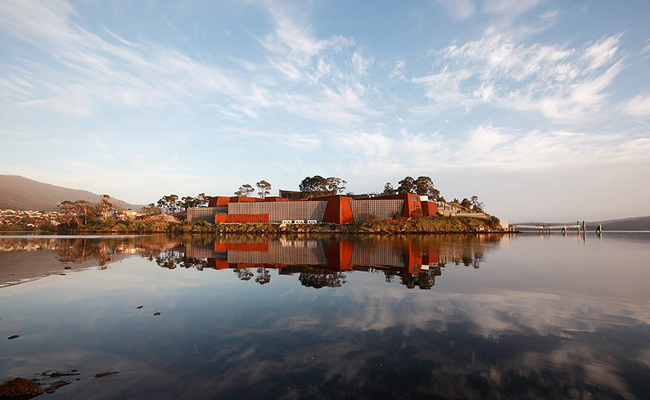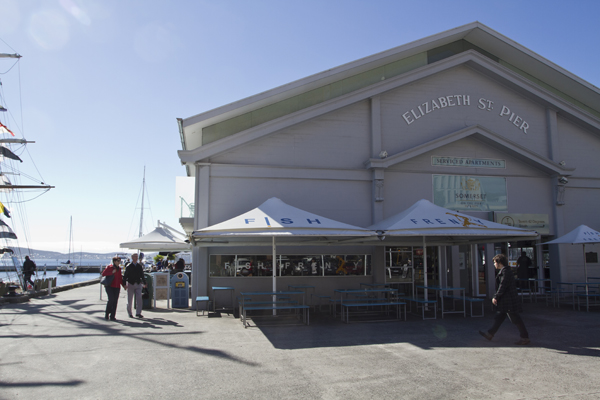I got a rental car to drive out to MONA, the very strange Museum of Old and New Art about 20 minutes up the River Derwent, but then the concierge at my hotel said there wasn’t much parking available at the museum and that, for $15, you could take the ferry there, so what the hell; I took the ferry.
While I was waiting for the boat to arrive, I went into a shop along the wharf and bought a polar fleece jacket just to keep me warm on the short trip over the water. I also thought about getting a wool hat but didn’t. I guess the one thing that has surprised me the most about Hobart and Tasmania is how damn cold it’s been. I mean, this is Australia and it’s summer down here but it feels more like Seattle in the fall. I have to keep reminding myself that the major meteorological influence down here is the Southern Ocean and that Hobart was the departure point for Antarctic explorers like Douglas Mawson and Ernest Shackleton.
When I told an Australian friend of mine, who lives in New York, that I was going to Hobart, he said, “Oh, are you going to the death and sex museum?” I had no idea what he was talking about. So he told me about MONA, Australia’s largest and certainly most bizarre private museum whose owner, David Walsh, likes to call it “a subversive adult Disneyland.”
The reason my friend called it the “death and sex museum” is because those are the artistic subjects David Walsh is most interested in. In the introduction to a book about the museum, Walsh wrote: “My name is David Walsh and I’m an arseholic. I originally wrote: ‘My name is David Walsh and I’m an artoholic.’ I thought it was pretty clever but it turns out I was plagiarizing the title of a book by Charles Saatchi, the controversial English collector and dealer. So I changed the first sentence to something completely different and ploughed on…You should know that the most important forces behind me and this museum stem from my dark side.”
Well, that’s just coming right out with it, isn’t it?
In 1995, Walsh purchased the land where the museum is located and installed a Museum of Antiquities. He likes to say that nobody came, so he decided to expand. He met a Melbourne architect, Nonda Katsalidis, and asked him to design a large building for his art that would allow it to be discovered rather than shown off, so that the connection (or not) with the viewer is built from personal experience rather than something imposed.
So how does one do that? By basically removing a mountain of sandstone and building down into the ground, instead of above it, and then encouraging people to sort of wander about as if in a maze. In other words, wander aimlessly and see what floats your boat. Or not.
So who is this David Walsh? According to Wikipedia, he’s a “Tasmanian millionaire, entrepreneur, and owner of a large private art collection.” According to my Australian friend in New York, he’s an autodidact who has made a fortune coming up with a gambling system to beat the house odds. Supposedly he made so much money gambling that certain casinos “bought” his system and then forbid him from using it.
Anyway, he took $75 million of that money to build MONA which opened a little over a year ago. And people are flocking to it. One other thing I might mention: My New York friend told me that when I visited MONA I should be sure and arrive before 2pm. I asked him why. He said, “That’s when the poop installation takes a shit.”
Wouldn’t want to miss that, would we.







Recent Comments